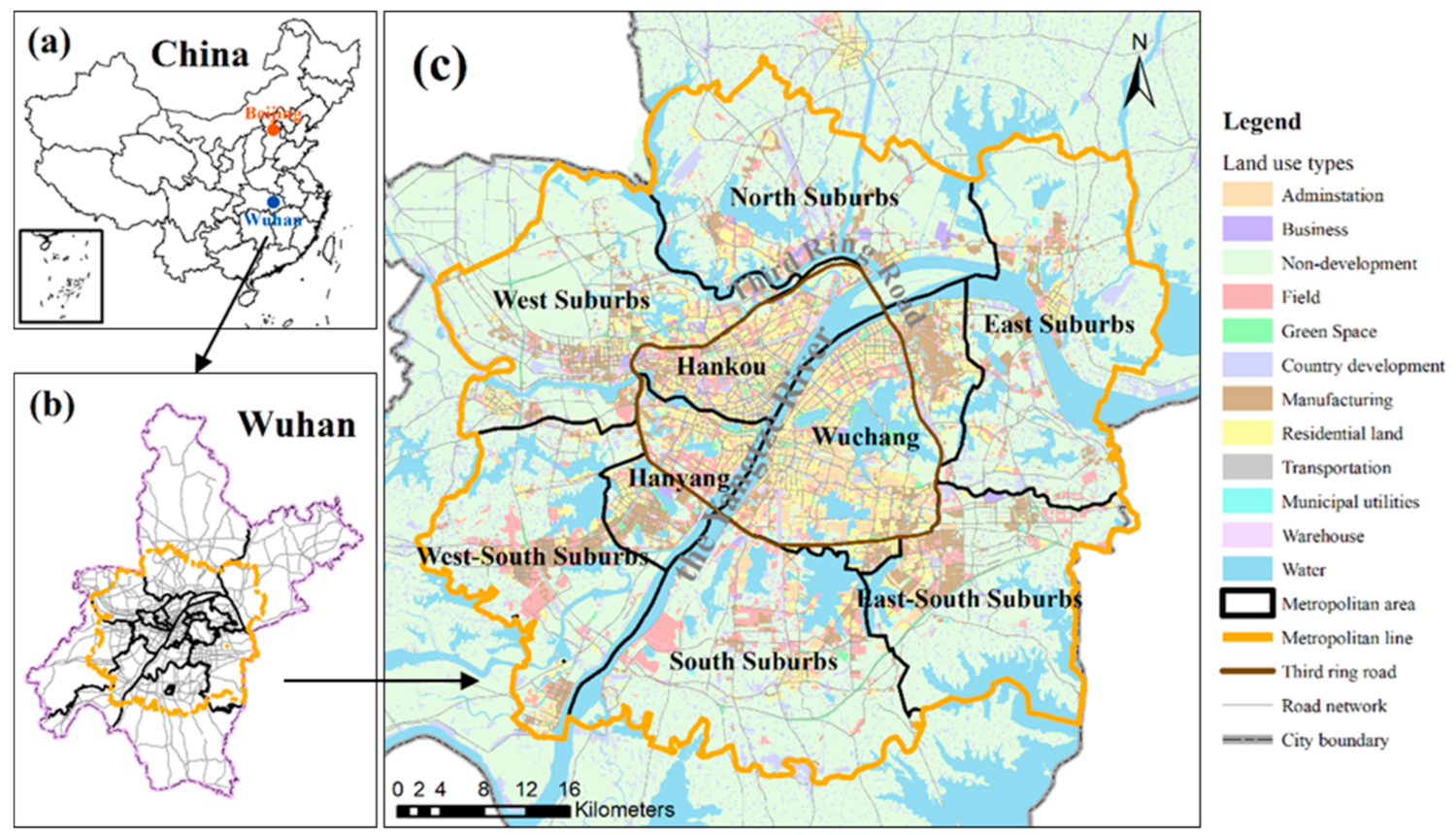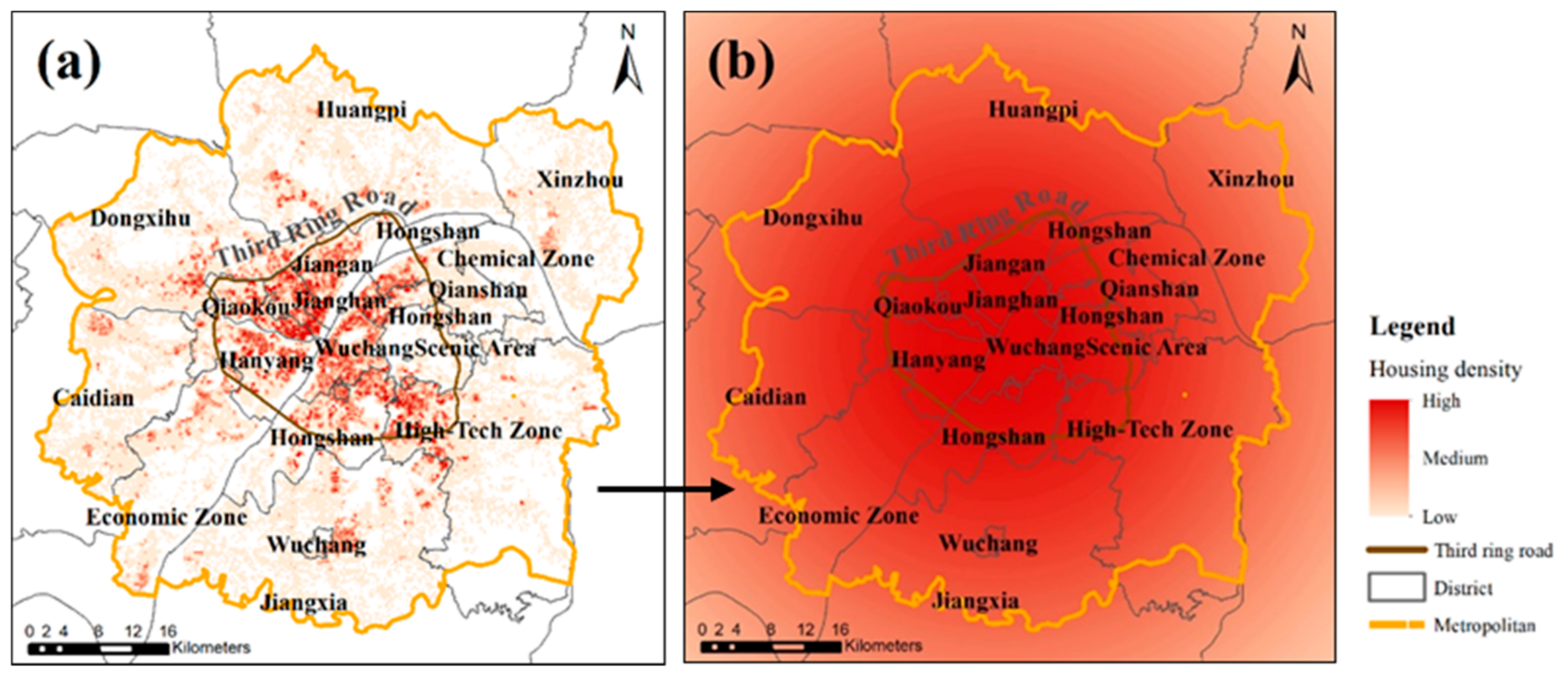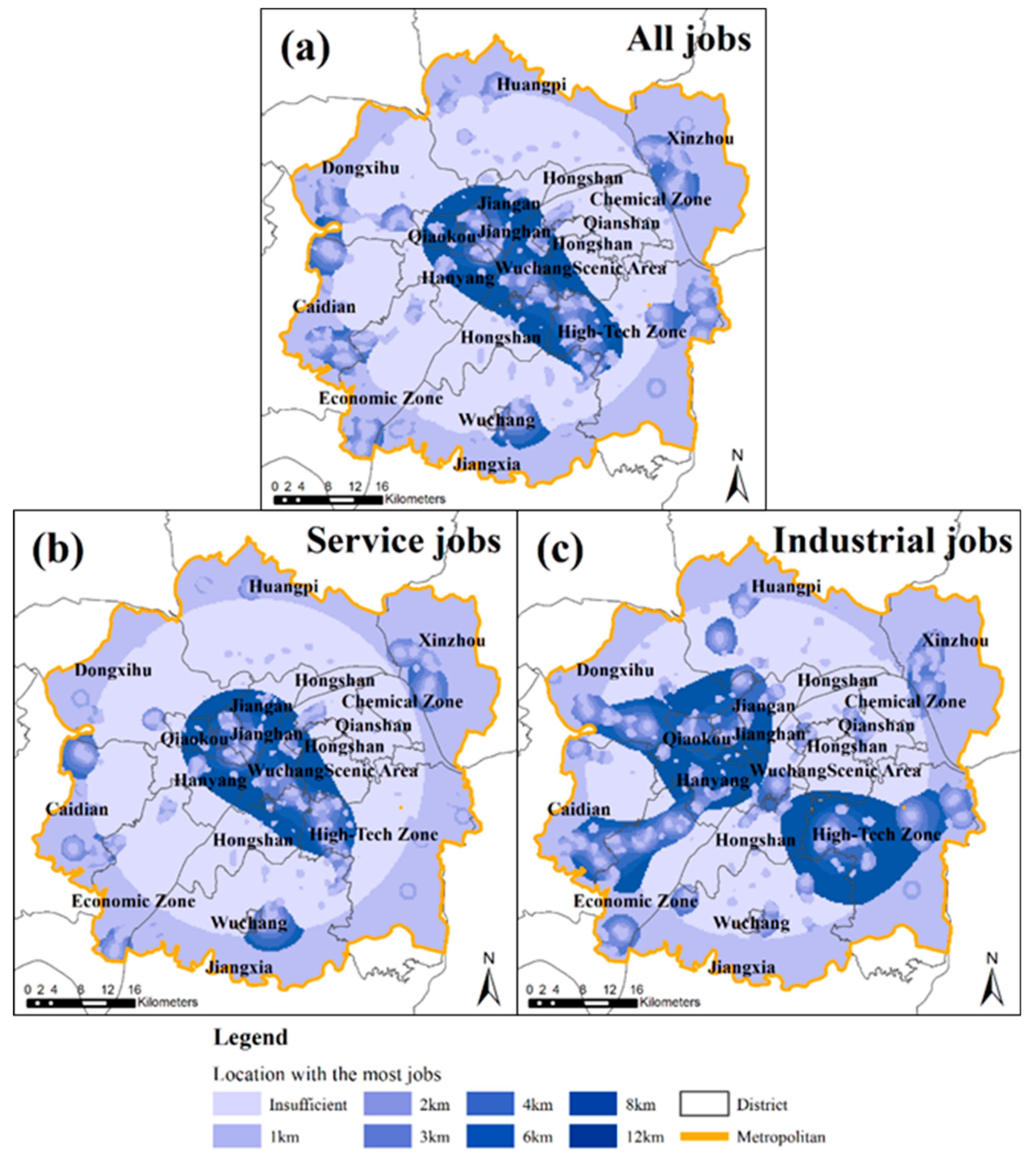Job Accessibility from a Multiple Commuting Circles Perspective Using Baidu Location Data: A Case Study of Wuhan, China
Abstract
:1. Introduction
2. Data and Methodology
2.1. Study Area
2.2. Data
2.2.1. Baidu Users’ Locations
2.2.2. Land Use
2.3. Methodology
2.3.1. Kernel Density Estimation
2.3.2. The Jobs–Housing Spatial Structure and Transport Service Supply
2.3.3. Job Accessibility
3. Results
3.1. Spatial Distribution of Housing and Job Opportunities
3.2. Job Accessibility for Housing Grids
3.3. Comparison Between New and Traditional Job Accessibility Measurements
3.4. Disparity Between Transport Service Supply and Commuting Demand
4. Discussion
4.1. The Characteristics of Job Accessibility and Transit Service Optimization
4.2. Comparison between New and Traditional Methods
4.3. Limitations
5. Conclusions
Author Contributions
Funding
Conflicts of Interest
References
- Cervero, R. Job-housing balance and regional mobility. J. Am. Plan. Assoc. 1989, 55, 136–150. [Google Scholar] [CrossRef]
- Giuliano, G. Is job-housing balance a transportation issue? Transp. Res. Rec. 1991, 13, 305–312. [Google Scholar]
- Evans, H. New Towns: The British Experience; Charles Knight & Co. Ltd.: London, UK, 1972. [Google Scholar]
- Cervero, R. Sustainable New Towns: Stockholm’s Rail-served Satellites. Cities 1995, 12, 41–51. [Google Scholar] [CrossRef]
- Ma, L.J.C. Urban transformation in China, 1949-2000: A review and research agenda. Environ. Plan. A 2002, 34, 1545–1569. [Google Scholar] [CrossRef]
- Ma, L.J.C.; Wu, F. Restructuring the Chinese City: Changing Society, Economy and Space; Routledge: London, UK, 2005. [Google Scholar]
- Yang, J. Transportation implications of land development in a transitional economy: Evidence from housing relocation in Beijing. Transp. Res. Rec. 2006, 1954, 7–14. [Google Scholar] [CrossRef]
- Liu, W.; Yan, X.; Fang, Y.; Cao, X. Related Characteristics and Mechanisms for Excess Commuting in Guangzhou. Acta Geogr. Sin. 2008, 63, 1085–1096. [Google Scholar]
- Wang, D.; Chai, Y. The jobs–housing relationship and commuting in Beijing, China: The legacy of Danwei. J. Transp. Geogr. 2009, 17, 30–38. [Google Scholar] [CrossRef]
- Zhou, J.; Zhang, C.; Chen, X.; Huang, W.; Yu, P. Has the legacy of Danwei persisted in transformations? The job-housing balance and commuting efficiency in Xi’an. J. Transp. Geogr. 2014, 40, 64–76. [Google Scholar]
- Li, Q.; Lu, X. The characteristics of resident’s working-trip in inner-suburb of Beijing. Urban Probl. 2007, 7, 55–59. [Google Scholar]
- Meng, B.; Yu, H.; Zheng, L. The analysis of commuting behavior in the huge residential districts: A case study of Wangjing and Tiantongyuan in Beijing. Geogr. Res. 2012, 31, 2069–2079. [Google Scholar]
- Tian, J.; Wang, D.; Xie, D.; Zhu, W. Identifying the commuting features and patterns of typical em-ployment areas in Shanghai using cellphone signaling data: A case study in Zhangjiang, Jinqiao and Lujiazui. Geogr. Res. 2017, 36, 134–148. [Google Scholar]
- Palmer, A. Health of People Who Travel to Work: The Effect of Time Travel and Mode of Transport on Health; Centre for Health Services Studies University of Kent: Kent, UK, 2005. [Google Scholar]
- Hansson, E.; Mattisson, K.; Björk, J.; Östergren, P.; Jakobsson, K. Relationship between commuting and health outcomes in a cross-sectional. BMC Public Health 2011, 11, 834–847. [Google Scholar] [CrossRef]
- Oliveira, R.; Moura, K.; Viana, J.; Tigre, R.; Sampaio, B. Commute duration and health: Empirical evidence from Brazil. Transp. Res. Part A Policy Pract. 2015, 80, 62–75. [Google Scholar] [CrossRef]
- Fu, T.; Zhang, Y.; Chai, Y. Implications of commuting pattern for suburban residents’ health in large Chinese cities: Evidences from Tiantongyuan in Beijing. Prog. Geogr. 2018, 37, 547–555. [Google Scholar]
- Zhou, Y.; Ma, L.J. Economic restructuring and suburbanization in China. Urban Geogr. 2000, 21, 205–236. [Google Scholar] [CrossRef]
- Lu, W.; Chen, W. Manufacturing industry enterprises location choice and the urban spatial restructuring in Nanjing. ACTA Geogr. Sin.-Chin. Ed. 2009, 64, 142–152. [Google Scholar]
- Wu, F. Changes in the structure of public housing provision in urban China. Urban Stud. 1996, 33, 1601–1627. [Google Scholar] [CrossRef]
- Chai, Y.; Liu, Z.; Shen, J. Changes of the Danwei system and its effects. Arid Land Geogr. 2008, 31, 155–163. [Google Scholar]
- Wang, F. Modeling commuting patterns in Chicago in a GIS environment: A job accessibility perspective. Prof. Geogr. 2000, 52, 120–133. [Google Scholar] [CrossRef]
- Ma, Q.; Zhang, W. Characteristics and factors analyses of suburbanization in Beijing. Geogr. Res. 2006, 25, 121–130. [Google Scholar]
- Giuliano, G.; Kenneth, A.S. Is the journey to work explained by urban spatial structure? Urban Stud. 1993, 30, 1485–1500. [Google Scholar] [CrossRef]
- Cervero, R. Job-housing Balance as Public Policy. Urban Land 1991, 50, 153–169. [Google Scholar]
- Thomas, R. London’s New Towns: A Study of Self-Contained and Balanced Communities; PEP: London, UK, 1969. [Google Scholar]
- Cervero, R. Job-housing balance revisited: Trends and impacts in the San Francisco Bay Area. J. Am. Plan. Assoc. 1996, 62, 492–511. [Google Scholar] [CrossRef]
- Martin, R.W. Spatial mismatch and the structure of American metropolitan areas, 1970–2000. J. Reg. Sci. 2004, 44, 467–488. [Google Scholar] [CrossRef]
- Sun, T.; Liu, X. Job-housing Spatial Mismatch of Permanent Immigrants and Local Registered Residents in Chinese Metropolises: An Empirical Study Based on Beijing, Shanghai and Guangzhou. Popul. Econ. 2016, 5, 23–34. [Google Scholar]
- Hansen, W.G. How accessibility shapes land use. J. Am. Plan. Assoc. 1959, 25, 73–76. [Google Scholar] [CrossRef]
- Handy, S.L.; Niemeier, D.A. Measuring accessibility: An exploration of issues and alternatives. Environ. Plan. A 1997, 29, 1175–1194. [Google Scholar] [CrossRef]
- Tilahun, N.; Fan, Y. Transit and job accessibility: An empirical study of access to competitive clusters and regional growth strategies for enhancing transit accessibility. Transp. Policy 2014, 33, 17–25. [Google Scholar] [CrossRef]
- Levinson, D.M. Accessibility and the journey to work. J. Transp. Geogr. 1998, 6, 11–21. [Google Scholar] [CrossRef]
- Gibb, K.; Osland, L.; Pryce, G. Describing inequalities in access to employment and the associated geography of wellbeing. Urban Stud. 2014, 51, 596–613. [Google Scholar] [CrossRef]
- Hu, L.; Fan, Y.; Sun, T. Spatial or socioeconomic inequality? Job accessibility changes for low- and high-education population in Beijing, China. Cities 2017, 66, 23–33. [Google Scholar] [CrossRef]
- Ahas, R.; Aasa, A.; Silm, S.; Tiru, M. Daily rhythms of suburban commuters’ movements in the Tallinn metropolitan area: Case study with mobile positioning data. Transp. Res. Part C Emerg. Technol. 2010, 18, 45–54. [Google Scholar] [CrossRef]
- Yuan, Y.; Raubal, M.; Liu, Y. Correlating mobile phone usage and travel behavior: A case study of Harbin, China. Comput. Environ. Urban Syst. 2012, 36, 118–130. [Google Scholar] [CrossRef]
- Niu, X.; Ding, L. Analyzing job-housing spatial relationship in Shanghai using mobile phone data: Some conclusions and discussions. Shanghai Urban Plan. Rev. 2015, 121, 39–43. [Google Scholar]
- Liu, X.; Long, Y. Automated identification and characterization of parcels with OpenStreetMap and points of interest. Environ. Plan. B Plan. Des. 2016, 43, 341–360. [Google Scholar] [CrossRef]
- Levingston, B.L. Using Jobs Housing Balance Indicators for Air Pollution Control; Institute of Transportation Studies, University of California: Berkeley, CA, USA, 1989. [Google Scholar]
- Deakin, E. Land use and transportation planning in response to congestion problems: A review and critique. Transp. Res. Rec. 1989, 1237, 77–86. [Google Scholar]
- Zhong, R. The Job-housing Balance and Urban Commuting. Urban Stud. 1997, 34, 1215–1235. [Google Scholar]
- Hu, J.; Zhu, L.; Lou, J. Characteristics and Evaluation of Job-housing Space of Wuhan. Hum. Geogr. 2014, 129, 76–82. [Google Scholar]
- Zhou, S.; Yan, X. Characteristics of Job-housing and Organization in Guangzhou. Sci. Geogr. Sin. 2005, 25, 664–670. [Google Scholar]
- Liu, B.; Shen, F. A Study on the Spatial Characteristics of Job-housing Structure in Beijing. Hum. Geogr. 2011, 26, 40–47. [Google Scholar]
- Sun, T.; Wang, L.; Li, G. Distributions of Population and Employment and Evolution of Spatial Structures in the Beijing Metropolitan Area. Sci. Geogr. Sin. 2012, 67, 829–840. [Google Scholar]
- Fotheringham, A.S.; Brunsdon, C.; Charlton, M. Quantitative Geography: Perspectives on Spatial Data Analysis; Sage: London, UK, 2000. [Google Scholar]
- Xun, S. Selection of bandwidth type and adjustment side in kernel density estimation over inhomogeneous backgrounds. Int. J. Geogr. Inf. Sci. 2010, 24, 643–660. [Google Scholar]
- Brunsdon, C. Estimating probability surfaces for geographical point data: An adaptive kernel algorithm. Comput. Geosci. 1995, 21, 877–894. [Google Scholar] [CrossRef]
- Anderson, T.K. Kernel density estimation and K-means clustering to profile road accident hotspots. Accid. Anal. Prev. 2009, 41, 359–364. [Google Scholar] [CrossRef]
- Yin, C.; Liu, Y.; Wei, X. Road Centrality and Urban Landscape Patterns in Wuhan City, China. J. Urban Plan. 2018, 144, 511–522. [Google Scholar] [CrossRef]
- Zhao, P. The impact of the built environment on individual workers’ commuting behavior in Beijing. Int. J. Sustain. Transp. 2013, 7, 389–415. [Google Scholar] [CrossRef]
- Shen, Q. Location characteristics of inner-city neighborhood and employment accessibility of low-wage workers. Environ. Plan. B 1998, 25, 345–365. [Google Scholar] [CrossRef]
- Wang, E.; Song, J.; Xu, T. From ‘spatial bond’ to ‘spatial mismatch’: An assessment of changing jobs–housing relationship in Beijing. Habitat Int. 2011, 35, 398–409. [Google Scholar] [CrossRef]
- Anselin, L. Local Indicators of Spatial Association—LISA. Geogr. Anal. 1995, 27, 93–115. [Google Scholar] [CrossRef]
- Getis, A.; Ord, J.K. The Analysis of Spatial Association by Use of Distance Statistics. Geogr. Anal. 1992, 24, 127–145. [Google Scholar] [CrossRef]
- Jiao, J.; Dillivan, M. Transit Deserts: The Gap between Demand and Supply. J. Public Transp. 2013, 16, 23–39. [Google Scholar] [CrossRef] [Green Version]
- Jiao, J. Identifying Transit Deserts in Major Texas Cities Where the Supplies Missed the Demands. J. Transp. Land Use 2017, 10, 529–540. [Google Scholar] [CrossRef]







| No. | Search Radius (km) | Commuting Mode 1 | Commuting Time (min) | Commuting Mode 2 | Commuting Time (min) |
|---|---|---|---|---|---|
| S0 | 1000 | walk | ≤15 | bike | ≤7.5 |
| S1 | 2000 | walk | ≤30 | bike | ≤15 |
| S2 | 3000 | walk | ≤45 | bike | ≤22.5 |
| S3 | 4000 | bike | ≤30 | bus | ≤15 |
| S4 | 6000 | bike | ≤45 | bus | ≤22.5 |
| S5 | 8000 | bike | ≤60 | bus | ≤30 |
| S6 | 12,000 | bus | ≤45 | \ | \ |
| Transport Service Supply | Code of Value’s Level | |
|---|---|---|
| High | Low | |
| Density of bus stations | HB | LB |
| Density of metro stations | HM | LM |
| Density of urban roads | HR | LR |
© 2019 by the authors. Licensee MDPI, Basel, Switzerland. This article is an open access article distributed under the terms and conditions of the Creative Commons Attribution (CC BY) license (http://creativecommons.org/licenses/by/4.0/).
Share and Cite
Cai, M.; Liu, Y.; Luo, M.; Xing, L.; Liu, Y. Job Accessibility from a Multiple Commuting Circles Perspective Using Baidu Location Data: A Case Study of Wuhan, China. Sustainability 2019, 11, 6696. https://doi.org/10.3390/su11236696
Cai M, Liu Y, Luo M, Xing L, Liu Y. Job Accessibility from a Multiple Commuting Circles Perspective Using Baidu Location Data: A Case Study of Wuhan, China. Sustainability. 2019; 11(23):6696. https://doi.org/10.3390/su11236696
Chicago/Turabian StyleCai, Mingming, Yaolin Liu, Minghai Luo, Lijun Xing, and Yanfang Liu. 2019. "Job Accessibility from a Multiple Commuting Circles Perspective Using Baidu Location Data: A Case Study of Wuhan, China" Sustainability 11, no. 23: 6696. https://doi.org/10.3390/su11236696




